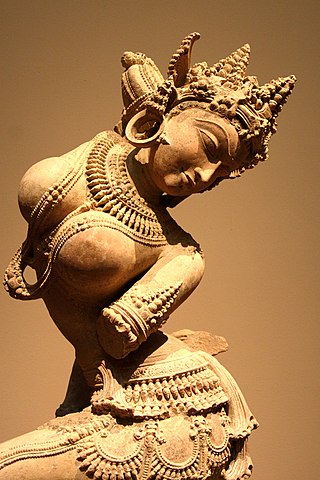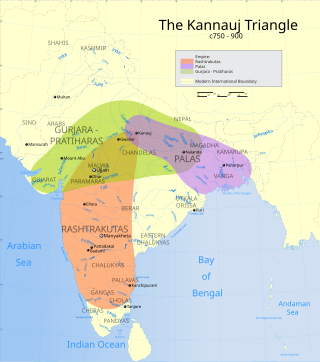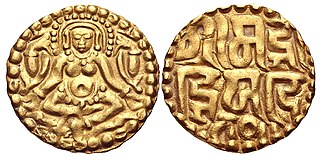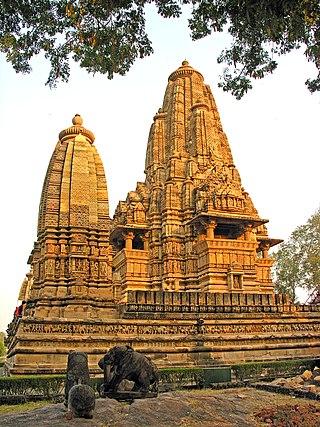Pratihara or Pratihar may refer to these dynasties of medieval India:
Pratihara or Pratihar may refer to these dynasties of medieval India:

Kannauj is an ancient city, administrative headquarters and a municipal board or Nagar Palika Parishad in Kannauj district in the Indian state of Uttar Pradesh. The city's name is an evolved form of the classical name Kanyakubja. In Ancient Vedic period, it was famous city of Panchala Mahajanpada and also its capital during Panchala king Vajrayudha.

The Pratihara dynasty was a medieval Indian dynasty that ruled parts of Northern India from the mid-8th to the 11th century. They ruled first at Ujjain and later at Kannauj. Before their victory in the Tripartite Struggle, they had initially ruled the Gurjaradesa; hence, they are also called the Gurjara-Pratiharas.
Gurjara, or Gurjar, may refer to;
Nagabhata I was the founder of the imperial Gurjara Pratihara dynasty in northern India. He ruled the Avanti region in present-day Madhya Pradesh, from his capital at Ujjain. He may have extended his control over Gurjaradesa, which includes parts of present-day Gujarat and Rajasthan. He repulsed an Arab invasion from Sindh, probably led by Junayd ibn Abd al-Rahman al-Murri or Al Hakam ibn Awana.
Nagabhata may refer to either of two kings in India in the 8th and 9th centuries:
Prithviraj, Pruthviraj or Prithvi Raj may refer to:
Mihira is an ancient Indian word meaning "Sun". It may refer to:
Jayasimha may refer to:

The Tripartite Struggle (785–816), also called the Kannauj Triangle Wars, was a conflict in northern India involving the three Indian great powers of the era – Gurjaratra, Bengal, and Manyakheta under the Pratiharas, the Palas and the Rashtrakutas respectively. The war was fought over the control of the Kingdom of Kannauj.
Mahipal (1919–2005) was an Indian film actor.
Bhoja was a philosopher king and polymath of the Paramara Dynasty.
Suryavanshi or Suryawanshi may refer to:
Gurjaradesa,, or is a historical region in India comprising the southern Rajasthan and northern Gujarat during the period of 6th–12th century CE. The predominant power of the region, the Gurjara-Pratiharas eventually controlled a major part of North India centered at Kannauj. The modern state of "Gujarat" derives its name from the ancient Gurjaratra.
Bhoja II may refer to any of the following Indian kings:

The Chahamanas of Shakambhari, colloquially known as the Chauhans of Sambhar or Chauhans of Ajmer, were an Indian dynasty that ruled parts of the present-day Rajasthan and neighbouring areas in India, between the 6th and 12th centuries. The territory ruled by them was known as Sapadalaksha. They were the most prominent ruling family of the Chahamana (Chauhan) Rajput clan.

The Kalachuris of Tripuri, also known the Kalachuris of Chedi, ruled parts of central India during 7th to 13th centuries. They are also known as the Later Kalachuris to distinguish them from their earlier namesakes, especially the Kalachuris of Mahishmati. Their core territory included the historical Chedi region, and their capital was located at Tripuri.

Yashovarman, also known as Lakshavarman, was a king of the Chandela dynasty of India. He ruled in the Jejakabhukti region. He practically established the Chandelas as a sovereign power, although he formally acknowledged suzerainty of the Gurjara-Pratiharas. His major military achievement was the conquest of Kalanjara. He is also notable for having commissioned the Lakshmana Temple at Khajuraho.
Vakpatiraja I, also known as Vappayaraja, was an Indian king belonging to the Shakambhari Chahamana dynasty. He ruled the Sapadalaksha country, which included parts of present-day Rajasthan in north-western India. He appears to have made an attempt to throw off the Gurjara-Pratihara overlordship, and was the first Chahamana king to assume the title Maharaja.
Kakustha may refer to:
Ramadeva may refer to any of the following Indian kings: